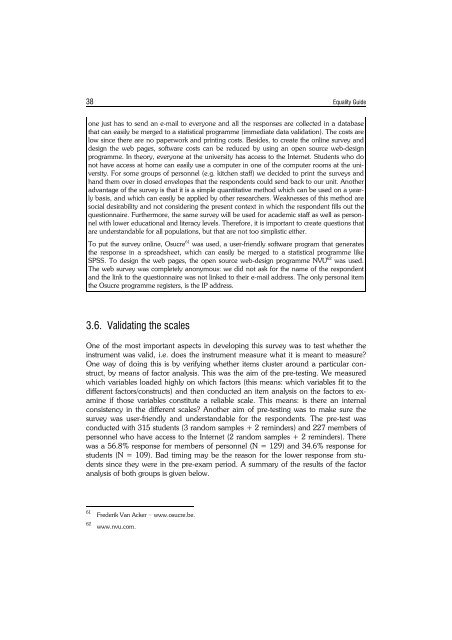EQUALITY GUIdE - KU Leuven
EQUALITY GUIdE - KU Leuven
EQUALITY GUIdE - KU Leuven
Create successful ePaper yourself
Turn your PDF publications into a flip-book with our unique Google optimized e-Paper software.
38 Equality Guide<br />
one just has to send an e-mail to everyone and all the responses are collected in a database<br />
that can easily be merged to a statistical programme (immediate data validation). The costs are<br />
low since there are no paperwork and printing costs. Besides, to create the online survey and<br />
design the web pages, software costs can be reduced by using an open source web-design<br />
programme. In theory, everyone at the university has access to the Internet. Students who do<br />
not have access at home can easily use a computer in one of the computer rooms at the university.<br />
For some groups of personnel (e.g. kitchen staff) we decided to print the surveys and<br />
hand them over in closed envelopes that the respondents could send back to our unit. Another<br />
advantage of the survey is that it is a simple quantitative method which can be used on a yearly<br />
basis, and which can easily be applied by other researchers. Weaknesses of this method are<br />
social desirability and not considering the present context in which the respondent fills out the<br />
questionnaire. Furthermore, the same survey will be used for academic staff as well as personnel<br />
with lower educational and literacy levels. Therefore, it is important to create questions that<br />
are understandable for all populations, but that are not too simplistic either.<br />
To put the survey online, Osucre 61 was used, a user-friendly software program that generates<br />
the response in a spreadsheet, which can easily be merged to a statistical programme like<br />
SPSS. To design the web pages, the open source web-design programme NVU 62 was used.<br />
The web survey was completely anonymous: we did not ask for the name of the respondent<br />
and the link to the questionnaire was not linked to their e-mail address. The only personal item<br />
the Osucre programme registers, is the IP address.<br />
3.6. Validating the scales<br />
One of the most important aspects in developing this survey was to test whether the<br />
instrument was valid, i.e. does the instrument measure what it is meant to measure?<br />
One way of doing this is by verifying whether items cluster around a particular construct,<br />
by means of factor analysis. This was the aim of the pre-testing. We measured<br />
which variables loaded highly on which factors (this means: which variables fit to the<br />
different factors/constructs) and then conducted an item analysis on the factors to examine<br />
if those variables constitute a reliable scale. This means: is there an internal<br />
consistency in the different scales? Another aim of pre-testing was to make sure the<br />
survey was user-friendly and understandable for the respondents. The pre-test was<br />
conducted with 315 students (3 random samples + 2 reminders) and 227 members of<br />
personnel who have access to the Internet (2 random samples + 2 reminders). There<br />
was a 56.8% response for members of personnel (N = 129) and 34.6% response for<br />
students (N = 109). Bad timing may be the reason for the lower response from students<br />
since they were in the pre-exam period. A summary of the results of the factor<br />
analysis of both groups is given below.<br />
61<br />
62<br />
Frederik Van Acker ! www.osucre.be.<br />
www.nvu.com.

















